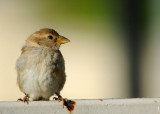

Try scattering some seed mix or sunflower hearts on the floor in a safe area of your garden. They enjoy eating natural foods such as insects and worms but also like to snack on seeds, especially during the winter months
#SPARROW VS WREN HOW TO#
How to attract dunnocks to your gardenįood is a great way to attract dunnocks to your garden. The Dunnock inhabits a wide variety of bushy areas including scrub, heaths, parks and gardens, also woodland. The female incubates the eggs for about twelve days, although both sexes tend the young. The Dunnock lays four or five uniform bright blue (very rarely with small reddish markings), or plain white eggs. The nest is built by both sexes from twigs, moss, dry leaves and other plant material and is usually situated between a half to three metres above the ground in a tree or among shrubs and bushes. When do dunnocks nest?īreeding starts in early April (sometimes March). Dunnock callĪ high-pitched, whistling ‘tseep’. The behaviour of a dunnock is what will give it away compared to a wren – it is much more likely to land on your lawn and, unlike a wren, won’t cock its tail upwards when it does so. Difference between a dunnock and a wrenĭunnocks have similar songs to wrens but are somewhat different in appearance, looking more like a female sparrow with a more greyish colour on the front and without markings around the eyes. In addition, while sparrows have thick beaks, the beak of a dunnock is thin and pointy. The best places to look are the head and beak – where a house sparrow has a brown head with either a grey crown (male) or a brown crown (female), a dunnock has a blue-grey head. Difference between a dunnock and a sparrowĭunnocks and sparrows are similar in appearance, so there are a number of ways in which you might find it difficult to tell the difference between the two. Generally an inconspicuous bird, often remaining undercover. It perches on low branches among leaves and flies for short distances. The Dunnock hunts for food on the ground among dead leaves, either hopping about or dragging its body almost horizontally along the ground, with its legs bent and its belly almost brushing the earth. The youngsters are less reddish and more heavily speckled, their heads are also browner. The adult has black streaks on its upper parts, brown crown and ear coverts and a narrow, dull yellow wing-bar.

They grey head and under parts and the thin insect-eating bill distinguish it from the others.

The Dunnock is similar to the female House Sparrow, it is often called the hedge sparrow. Dunnock identification: what does a dunnock look like?


 0 kommentar(er)
0 kommentar(er)
